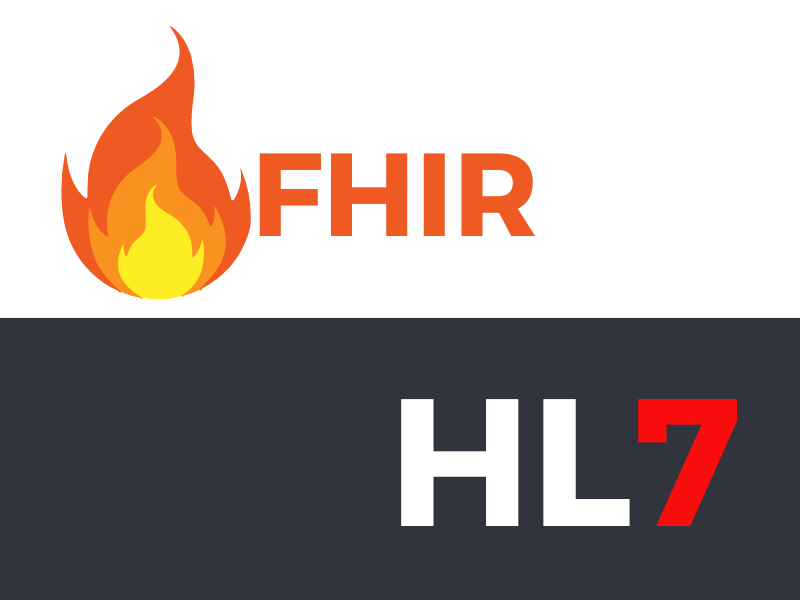HL7 and FHIR are messaging standards that enable interoperability among different healthcare technologies. HL7 is an older standard that relies on traditional messaging systems, while FHIR is a more modern version that enables mobile compatibility.
Both FHIR and HL7 enable health systems to communicate and share data efficiently. However, they differ in several key aspects.
Table of Contents

Understanding FHIR vs HL7 Standards
As health technology progressed, rapid developments in healthcare systems exposed the need for a messaging standard that can connect disparate systems. Health Level Seven International created HL7 and FHIR, both serving as standards for exchanging healthcare data.
After all, a fully connected and interoperable system enables healthcare providers to access data with improved accuracy and efficiency. This seamless exchange of information promotes better coordination, which leads to improved decision-making and personalized treatment plans.
HL7 features and capabilities
Health Level Seven International (HL7) is an international standard widely used for data management in hospital systems. Meaningful Use, a US federal incentive program, encouraged hospitals to adopt certified electronic health record (EHR) systems using HL7 standards, eventually leading to its widespread adoption.
HL7 primarily uses the XML messaging format and has two main versions, HL7 V2 and HL7 V3. V2 is a legacy system that defines messaging only and doesn’t cover data storage. It also has interoperability issues and an outdated design.
V3 addresses the shortcomings of V2 and uses the concept of RIM (Reference Information Model), a universal reference model for all information needed in the healthcare industry. However, RIM’s rigidity and static nature have resulted in complex and costly implementation processes.
XML can also be challenging to read and parse, especially on mobile devices. These limitations paved the way for the development of FHIR, a newer standard that can cope with evolving health systems.
FHIR features and capabilities
Fast Healthcare Interoperability Resources (FHIR) is an open standard that provides numerous benefits over its legacy counterpart, the HL7. It offers enhanced security measures, mobile device compatibility, and simpler implementation. It also facilitates the exchange of data between new applications and legacy systems.
Data exchange involves complicated processes, but FHIR simplifies them by utilizing the same technology and agreements that travel websites use for airlines. FHIR uses discrete exchange units (resources) and starter APIs for popular programming languages.
FHIR supports JSON and XML messaging formats, offering a flexible solution for various healthcare systems. Additionally, JSON is a lightweight format that enables compatibility with mobile applications and devices.
FHIR also utilizes RESTful APIs and open web technologies to facilitate quick data exchange. This greatly enhances interoperability among healthcare systems compared to HL7’s capabilities.

FHIR and HL7: Key Differences
| HL7 | FHIR | |
| Messaging Formats | Supports XML only | Supports XML and JSON |
| Data exchange | Uses traditional messaging systems | Uses RESTful APIs and open web technologies |
| Interoperability | Offers limited interoperability to devices and systems using the same legacy formats | Offers enhanced interoperability with a broad range of devices and applications |
Comparing HL7 vs FHIR, it’s clear that FHIR offers a significant improvement as opposed to HL7’s capabilities. FHIR’s capabilities enable faster data exchange and expanded interoperability, which helps healthcare providers access patient data better and deliver improved care.
Both HL7 and FHIR play a significant role in secure and interoperable healthcare data exchange. As healthcare institutions continue to adopt modern technologies and embrace digital transformation, it’s inevitable that FHIR will become the more commonly used standard.

The Impact of FHIR and HL7 on Healthcare Data Exchange
It’s undeniable that FHIR and HL7 contribute significantly to an efficient healthcare data exchange. Here’s how these standards are used in today’s modern health environment.
HL7 use cases
Despite its limitations, HL7 remains a popular standard for hospital systems. HL7 V2 allows data transmission between medical systems in one organization that doesn’t require data storage, such as admit discharge transfer patients, medical prescriptions, financial transactions, and observation results.
HL7 V2 cannot scale across different organizations. This limitation is addressed by HL7 V3, especially the variant that uses CDA (Clinical Data Architecture). HL7 V3 has the same use cases as HL7 V2, with fewer communication issues.
As such, HL7 enables:
- Smooth collection and processing of patient data
- Access to patient records and documents
- Efficient processing of billing claims due to the connection between patient records and billing systems
FHIR use cases
As an improvement of HL7, FHIR also has the same use cases with one major addition: the development of mobile applications and devices. Because of FHIR’s capabilities, it enables developers to create innovative applications to enhance patient engagement and drive better care.
FHIR can be leveraged in mobile health apps to enable patients to access and manage their own health data. Patients can use these apps to view lab results, track medications, schedule appointments, and communicate with healthcare providers, all while adhering to privacy and security standards.
It also supports exchanging real-time patient data captured from remote monitoring devices, wearables, and telemedicine platforms. This allows healthcare providers to monitor patients remotely, track vital signs, manage chronic conditions, and intervene promptly when necessary without requiring in-person visits.
With FHIR, healthcare organizations can enjoy these benefits:
- Better patient engagement
- On-demand access to critical patient information
- More accurate diagnoses
- Better patient outcomes
- More innovative healthcare solutions
Ensure Seamless Interoperability With iFax
Why risk using multiple platforms when a comprehensive platform like iFax can offer all the tools you need for seamless communications? Best of all, iFax adheres to HL7 and FHIR standards.
Our HIPAA-compliant fax and messaging platform lets you fax documents, exchange secure messages, and even make calls, all without the inconvenience of switching between apps.
It also uses enterprise-level encryption technology and has employed advanced security measures to prevent unwanted access. You can also integrate its messaging and fax capabilities into existing EHR and EMR systems through API.
Request a demo of iFax today or select a plan.







